|
(Table12)
12-1. The international decision to follow print, putting text material into
braille text rather than braille signs, has enabled general agreement
on theory notation. This agreement is particularly helpful when blind and
sighted musicians are studying or working together.
A. Chord Symbols
12-2. Many types of music publications from hymns to general song books to
fake books (words only) and other popular music now include chord
symbols as a routine practice. Some of these are very simple indications
such as "G" or "D7" and others are very complex. Most can be written in
literary braille with the addition of music signs for pitch alteration and
the following signs from Table 12 A that have international approval.
Example 12-2.

 |
Prefix for a chord symbol part |
 |
Small circle |

 |
Small circle bisected by line |
 |
Small triangle |

 |
Small triangle bisected by line |


 |
Italicized 7 for a specialized seventh chord |
12-3. The signs for plus, minus, parentheses, oblique stroke, capital and
lower case letters, and italics are part of the literary code of each
country and should be listed in each publication. Those used in this
publication are shown below:
Example 12-3.
 Oblique stroke / Oblique stroke /
  Parentheses ( ) Parentheses ( )
 Plus sign + Plus sign +
 Minus sign or literary hyphen - Minus sign or literary hyphen -
 Lower case letter d Lower case letter d
 Capital letter D Capital letter D
12-4. The standard music signs are used for accidentals; dot 3 is used for
periods.
12-5. Numbers are preceded by the numeral sign and written in normal,
upper-cell position. If printed vertically, the numerals are brailled from
lowest to highest.
12-6. The following is a representative list of possible chord symbols using
the international signs.
Example 12-6.
| Dm |
 
 |
| Dmaj7 |
 
  
 
|
| F#dim7 |
 
  
  
|
| F#¼7 |
 
  
 |
| C7sus |
  
  
 |
| Dm(#7) |
  
  
  |
| B7-9 |
  
  
 |
| Gmaj7+9 |
  
  
  
 |
12-7. In bar-over-bar formats, chord symbols are aligned beneath the text
lines or beneath the music. No prefix is used; the placement is enough to
identify these as chord symbols. Example 12-7 shows popular or folk
music when song text is given only with chord symbols in a "lead sheet"
for use with guitar, other plucked instruments or improvised on a
keyboard. In print, the chord symbols are aligned above the text; in
braille they are aligned below.
Example 12-7.
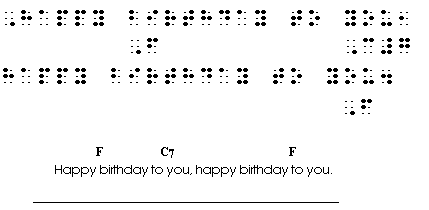
12-8 . When a melody is also provided, it is added as a third line to the
parallel. Some countries always place the text above the melody;
others place it below. When chord symbols are aligned with text, the text
is spaced, if necessary, to accomodate the chord
alignment. Example 12-8 (a) has the text above and (b) has the
text below the melody. In both cases, the chord symbols are
aligned with the text. In (a), dots 3-6 are added as a filler for
spaces in the text, but they are not filled in (b). Neither version
fills spaces between chord symbols. At least one space must be
left between each chord symbol.
Example 12-8.
(a)
(b)

12-9. When chord symbols are aligned with the text, it is also possible to
indicate chords that precede or follow a word. This is done by placing
the chord symbol at least 2 cells to the left of a word or one cell to the
right. Punctuation is ignored when counting spaces after a word.
Example 12-9.

12-10. When chord symbols are placed below the melody, they may be
aligned with specific notes or with the beginnings of the appropriate
measures. In Example 12-10 the chord symbols are aligned at the
beginning of the measures, and a space is left between each chord
symbol.
Example 12-10.

12-11. If chord symbols are included with the piano accompaniment, they are
placed below the left hand part and are usually aligned with beginnings
of measures. The "tracker" dots (dot 3) below are part of the bar-over-
bar formats only.
Example 12-11.

12-12. The chord symbol prefix is used in section-by-section formats.
Example 12-12 is the same music as 12-11. In (a), the literary symbols
are placed in the chord symbol part after the prefix There are no
spaces between chords; a space is a bar line. Stem signs may follow
chord symbols to show value when the chords do not have the same
time value. Signs for repeats, prima and seconda volta, etc. may be
used as usual. Rests (preceded by dot 5) can be used to show measures
or beginnings of measures with no chord symbols. In (b) the bass line is
repeated after each chord symbol in order to show exact location.
Example 12-12.
(a)
(b)
12-13. Other local or national methods may be used to indicate note value with chord symbols.
12-14. Some print symbols, such as the small circle (diminished) and small
circle with a line through it (half-diminished), have standard meanings.
Others have different meanings in different publications; i.e, the small
triangle and the italicized 7 have been used to indicate major sevenths
and also diminished sevenths according to different composers. All
explanatory material will, of course, be included in the transcription. In
examples (a) and (b) below, the symbols are used to indicate major
seventh chords. In both cases, the meaning of the chord symbol was
explained at the beginning of the print publication. The prefix from Table
15 for the right hand part when intervals read up is used in these
examples. In 12-14(b), the "notes" are merely an indication of rhythm for
a jazz guitarist.
Example 12-14. (Intervals read up)
(a)
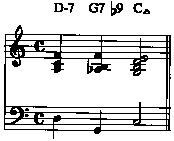
(b)

B. Figured Bass and Harmonic Analysis
Signs from Table 12 B.
  |
Prefix for a figured bass part |
 


 |
Numbers |





 |
Isolated accidentals |

 |
Omitted figure in a string of figures |

 |
A line of continuation |


 |
Two lines of
continuation |


 |
Figure (any number) that is crossed in print | |

 |
Oblique stroke |
 |
Separation of signs |
1. Figured Bass
12-15. Figured bass consists of numbers, accidentals and other "figures"
printed beneath specific notes in vertical columns. In braille, the figures
follow the specific notes. A number sign must indicate the beginning of
every column of figures, even if the "figure" is an accidental, an oblique
stroke, or other feature.
12-16. Numbers are written in the lower part of the cell.
12-17. The lowest figure of a column, in terms of placement in print rather
than numerical sequence, is placed first after a note and is followed by
the succeeding figures reading upwards.
12-18. Accidentals precede figures to which they apply.
12-19. An isolated accidental (indicating inflected third) is followed by dots 1-
3 except at the end of a bar.
12-20. A figure that is "crossed" (indicating that it is raised) is preceded by dots 5-6.
12-21. In a string of figures, an omitted figure is represented by dot 3.
12-22. When more than one column of figures appears under a single bass
note, each column begins with a number sign in braille. Example 12-22
illustrates the features listed in paragraphs 12-15 through 12-21.
Version (a) is in section format; version (b) is bar-over-bar. Some
countries who use section format write the left hand notes with the
figured bass as in (b) of this example, rather than writing a separate left-
hand part as in (a).
Example 12-22.
(a)
(b)

12-23. Dot 1 represents a print line of continuation. The number of dot 1's
equals the number of continuation lines. In Example 12-23, where there
are two numbers in a column, both numbers are followed by a print line
of continuation in the next column.
Example 12-23.

12-24. If it is necessary to indicate the rhythm of a change of figures on one
note, the figures should be followed by a stem sign showing the value of
the chord represented by each column of figures. This should only be
used where essential and where the print is quite clear as to the
intended rhythm.
Example 12-24.
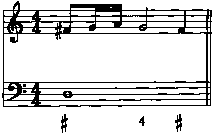
12-25. When notes with figures are followed by other musical signs (i.e.,
staccato) the sign with dots 3-6, -, separates the figured bass signs
from the music signs. At the beginning of a measure, as in Example 12-
25, the separation sign is not necessary.
Example 12-25.

12-26. If other notes appear on the staff with the bass line and figures, these
notes are usually written separately, after an in-accord sign. If small
notes are used in the print, they should be written using the small-note
sign in braille (Table 1).
Example 12-26.

12-27. An oblique stroke is represented by dots 3-4, preceded by the number
sign.
Example 12-27.
 2. Harmonic Analysis
2. Harmonic Analysis
12-28. When music is being used for harmonic analysis, it is common for the
intervals of all parts to be written upward. A statement about the
direction of intervals should appear in the transcription. If keyboard
hand signs are being used, the sign for the right hand part should
indicate that intervals read up,  
 , (Table 15). , (Table 15).
12-29. Harmonic analysis uses roman numerals and letters in addition to the
figures of figured bass.
12-30. Figures are written as in the preceding section of this chapter.
12-31. Roman numerals and letters follow print, using the capital or letter
signs according to the normal literary usage in each nation. American
capitals and letter signs are used in this edition.
12-32. Each chord symbol is separated by a space.
12-33 If the symbols need to be aligned with music, they are written on a line
below the notes and the music is spaced so that the start of each note-
group coincides with the first sign of the chord symbol. In this situation
the sign  is used to represent a bar-line. is used to represent a bar-line.
Example 12-33. (Intervals read up.)
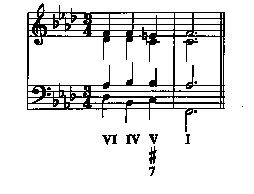
12-34. Example 12-34 is harmonic analysis from a theory textbook.
Version (a) is in bar-over-bar format with each beat aligned; version (b)
is in a section. Bar lines would be placed between measures. In both
cases, the lettering and capitalization is transcribed as it appears in
print
Example 12-34. (Intervals read up.)
(a)
(b)
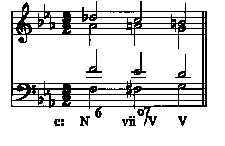
12-35. With this international system, unusual lettering and numbering can be
accommodated. Again, the exact lettering and capitalization of the print
is reproduced. Version (a) is bar-over-bar; version (b) is in a section.
Example 12-35. (Intervals read up.)
(a)
(b)
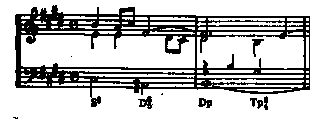
12-36. When letters represent passing notes, non-chord or auxiliary notes,
suspensions, etc. (using x, n, a, s etc. in print), either the letters, with
word signs, should precede the notes to which they refer or they should
be placed with letter signs (rather than word signs), on the same line as
the chord symbols, directly below the notes to which they apply. In
Example 12-36, upper case roman numerals represent major chords,
lower case represent minor chords, and Ic is an example of the I chord
with lettering that represents 2nd inversion. In (a), the symbols above
the staff in print precede the notes to which they apply and those below
the staff are aligned below the notes to which they apply; in (b), all the
signs are aligned below.
Example 12-36.
(a)
(b)

12-37. Chords are normally aligned vertically unless there can be no
confusion, i.e., if the print has explained their position. In Example 12-37 the
chords are not aligned. The print is the same as in Examples 12-36 (a) and (b).
Example 12-37.
12-38. When figured bass and roman numerals both appear in the bass, the
roman numerals can be placed underneath. When spacing is needed in
order to leave at least one space between each chord, the bar line sign
is used.
Example 12-38.
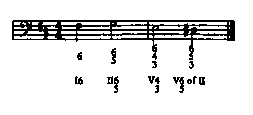
C. Brackets
Signs from Table 12 C.

 |
Music parentheses (round brackets) |



 |
Vertical brackets surrounding notes or features |



 |
Square bracket above the staff |



 |
Square bracket above staff with unclear ending
|




 |
Dotted square bracket above the staff |



 |
Square bracket below the staff |



 |
Square bracket below staff with unclear ending |





 |
Dotted square bracket below the staff |
12-39. The sign for music parentheses (round brackets) is used as follows.
Example 12-39.

12-40. But if the symbol in print is a vertical square bracket, that distinction
should be shown in braille.
Example 12-40.


12-41. Brackets above and below the staff are found commonly in harmonic
notation, such as Schenker Analysis. Wherever brackets occur,
in any kind of music, the signs above that have received international approval
are available.
12-42. Complete brackets consist of a horizontal line with a shorter line at
each end, drawn at a right angle to the horizontal. If the bracket is above
the line, the signs are used, and if it is below, the signs are used.
Example 12-42.

12-43. If the brackets are drawn with dashed or dotted lines, the sign for
dotted brackets is used.
Example 12-43.

12-44. When a bracket does not have a right angle at the end, it is
considered unclear where the exact ending occurs. In that case, the
sign "' is used at the end if the bracket is above the staff, and ,
1 is used if the bracket is below the staff.
Example 12-44.

|